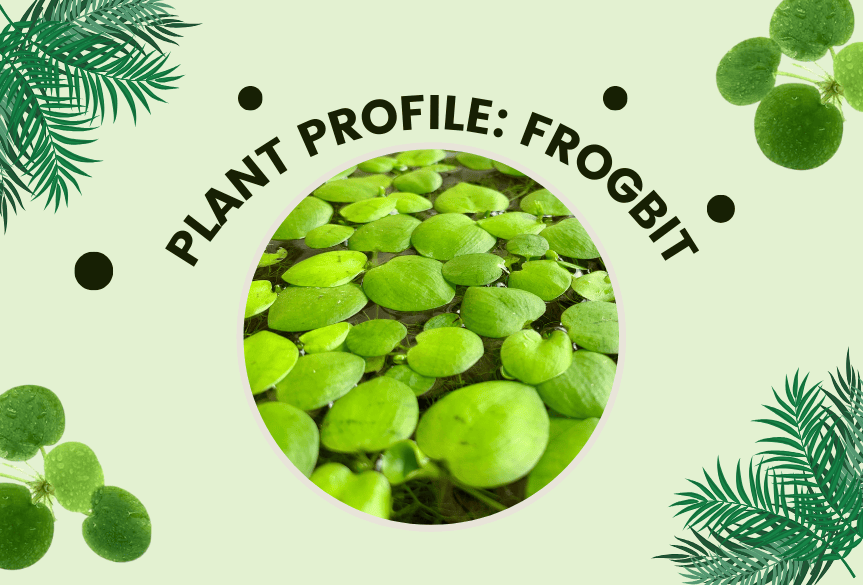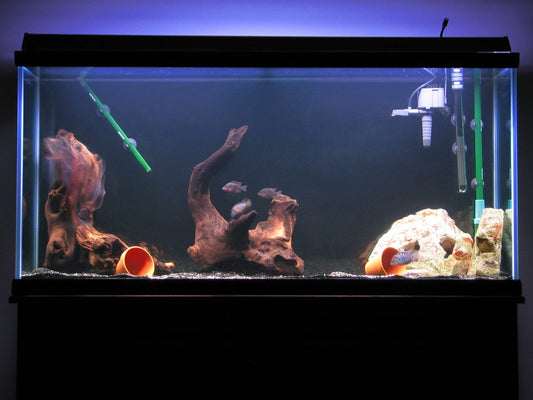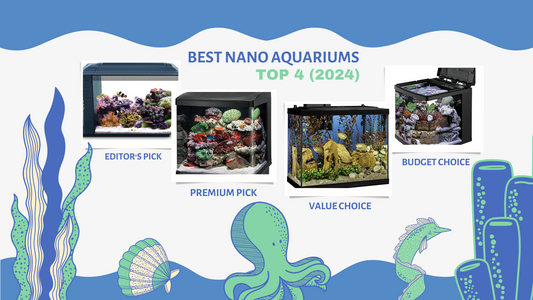Plant Profiles: Amazon Frogbit

If you're setting up your tank and are considering introducing some lush greens into it, the Amazon Frogbit has likely crossed your radar. This floating plant has been a mainstay in its native ecosystem for ages, but it is not only until recently that it has become a popular choice for many.
And it's just about time!
Venture into local fish stores, or chat with seasoned fish keepers, and you'll hear them refer to it as the Smooth Frogbit, South American spongeplant, or simply, the spongeplant. Whatever you choose to call it, there's no denying its captivating presence in water habitats.
But hey, the Amazon Frogbit offers more than just a pretty face!
Although considered easy to maintain, it does require particular attention, especially its bright green leaves. A quick pointer: perennially wet leaves are a Frogbit's nemesis!
No worries! In this Amazon Frogbit care guide, we'll share all you need to help your aquatic plant thrive. Let's make your aquarium the best it can be!
What is Amazon Frogbit
The Amazon Frogbit, scientifically known as Limnobium laevigatum and belonging to the family Hydrocharitaceae, originates from the aquatic ecosystems in Central and South America.
Although native to these countries, the appeal of the Amazon Frogbit transcended borders. One key reason? Its remarkable adaptability!
From hitching rides on birds and other animals to capitalizing on runoffs and floods, and not to mention, our human interactions, the Amazon Frogbit has found ways to spread far and wide.
In its natural habitat, the Amazon Frogbit loves warm climates and sunlit, nutrient-rich waters. You'll often find it floating in the shallow water of streams, ponds, and lakes, especially near edges. It's traditionally called a lake-dweller and shares similarities with water hyacinth.

Appearance of Frogbit Plants
One of the first things you might notice about this floating plant is its thick, spatula-shaped leaves that are smooth and free from marks or veins, identical to the freshwater plant water hyacinth. This is the reason why they are often confused in the hobby.
The younger leaves of Frogbit, heart-shaped with rounded lobes, float elegantly atop the water's surface with its bright green hue. But as they mature, they get bolder, producing leaves that rise above the surface of the water.
It's thanks to these leaves' spongy undersides that they can remain upright and buoyant on the water surface. And if we are getting science-y here, these spongy undersides are known as aerenchyma tissue.
But that's not all! On a good day, as your Frogbit basks in the right conditions, it might just produce small, white flowers that dance above the water, about an inch in size.
The best thing about it? It encourages flower pollination!
So, if you're lucky and provide the right care, don’t be surprised to find yellow or white blossoms making an appearance in your freshwater aquariums.
Size
The broad leaves of the Amazon Frogbit plants can grow up to a whopping 3 inches across! Given their size, these leaves can easily cover your water’s entire surface in no time.
Dive deeper, and you'll find the Amazon Frogbit roots reaching lengths of up to 20 inches. With their fine trailing hairs, they can get tangled up with other plants.
The result? Reduced sunlight and potential oxygen depletion in your water column, thanks to the double-whammy of these large leaves and lengthy roots.
With less sunlight and changing oxygen and CO2 levels, your other tank inhabitants might find themselves in a bit of a pickle.
That's why some folks suggest sticking to paludarium setups with the Amazon Frogbit. It gives them space to grow without overshadowing (literally!) other species.
Growth rate
Being larger than many floating plants, it doesn't need to grow as fast to dominate. Before you know it, this plant species can span a water surface with ease.
Oh, and a fun fact for you: the Amazon Frogbit can reach a height of 50cm!
With the rapid growth rate in both size and numbers, regular trimming becomes essential.
Whether it's sunlight or shade, optimal conditions or not, this floating aquatic plant has a knack for thriving. So, as you watch the Amazon Frogbit grow, remember to keep those scissors handy!
Are they invasive species?
The Amazon Frogbit, with its ability to spread rapidly and cover vast areas, is considered an invasive species in many countries such as Europe, Australia, and Africa.
In regions where it's not native, it can potentially outcompete local plants, disrupting aquatic ecosystems. Once it takes hold in a water body, eradicating it can be challenging.
This is why countries use local weed management agencies to ensure that it doesn't escape into local water bodies, preserving the natural harmony and protecting native species.
Two Varieties of the Amazon Frogbit Plant
If you've taken a keen interest in the Amazon Frogbit, you might be surprised to learn that there are two main varieties you should be aware of: the American and the European.
- American Frogbit The American Frogbit is the one most commonly found in aquariums and ponds. Recognized for its larger and robust leaves, it tends to have a faster growth rate, quickly covering the surface of water bodies. Its thick, spongy leaves are especially adapted to the warmer climates of its native regions in the southeastern US.
- European Frogbit Generally more petite and delicate in appearance than its American sibling, the European Frogbit is more cold-tolerant, making it a fit for the temperate climates prevalent in parts of Europe.
Benefits of having Amazon Frogbit Plants
Although there are known drawbacks to the Amazon Frogbit, just like any aquatic plant, it can be incredibly beneficial when managed correctly.
Covering the entire surface? No worries, just prune it back.
Concerned about your fish species not getting enough nutrients? The market is flooded with nutritional supplements to ensure they thrive!
Now, one most admirable trait of the Amazon frogbit plant is its contribution to biological control in the tank. They absorb excess nutrients from the water, effectively preventing unwanted algae blooms.
When algae have fewer nutrients to feed on, their growth is naturally restricted.
Additionally, the Frogbit's dense canopy offers a sanctuary for smaller aquatic life, and during the day, they perform the vital task of taking in carbon dioxide and releasing oxygen.
With a bit of care and attention, the Amazon Frogbit can prove to be an asset to your aquatic setup!
Amazon Frogbit Care

Caring for the Amazon Frogbit is a breeze. It's undemanding and extremely easy to tend to, making it perfect for both beginners and seasoned aquarium owners. Although it has preferred water parameters, it's versatile enough to thrive in shallow water.
Oh, and substrates? Forget about them! These guys revel in their floating lifestyle, no ground anchoring needed.
So, if you're looking for a plant that adds beauty without the fuss, the Amazon Frogbit is certainly worth considering.
Tank Size
The Amazon Frogbit can adapt and grow in just about any tank size. However, for the Frogbit to truly thrive, a 10-gallon tank or larger is preferred. This ensures it has the space it needs without hogging all the spotlight from its tank mates.
Now, if you are eyeing small-sized tanks, just remember they need a bit more care there. Its sensitivity to moisture means it needs extra attention in tighter spaces.
Water Tank Parameters
Diving into the specifics of keeping the Amazon Frogbit thriving, let's talk water parameters. After all, these parameters form the backbone of any successful home aquarium.
While the Amazon Frogbit is forgiving and can tolerate a range of parameters, there are certain ideal conditions it loves:
- Water Temperature: Prefers a range between 64°F to 84°F (18°C to 29°C).
- pH Level: A slightly acidic to neutral pH of 6.0 to 7.5 is ideal.
- Water Hardness: The amazon frogbit grows in soft water to moderately hard water, within the range of 4 to 12 dGH.
Now, while it's quite an adaptable plant, it's essential to maintain stability. Sudden shifts in any of these parameters can stress the Amazon Frogbit.
Water Flow
For the Amazon Frogbit, a gentle flow is optimal.
Strong currents can stress the plant and potentially push it underwater, which isn't ideal for this surface-loving species.
Their roots, which drift freely in the water column, benefit from a softer flow, allowing them to absorb nutrients without being thrashed about.
Now, if you've got a filter or pump creating strong currents, you might want to consider adjusting it or using barriers to ensure your Frogbit gets the calm environment it thrives in. The key here is to really just mimic their natural habitat.
Lighting Conditions
As sun-worshippers in their natural habitats, they thrive best under generous lighting conditions in freshwater aquariums.
Now, if you're thinking of setting the stage for these floating beauties, LED lights come highly recommended. They offer a consistent and energy-efficient light source, ensuring your Frogbit gets the illumination it craves without hiking up your electricity bill.
And who does not want that, right?
The Amazon frogbit truly thrives under moderate to high lighting conditions. However, striking the right balance is key. Shower them with ample light to prevent browning, but ensure it's not so intense that they scorch.
Ideally, a sweet spot of 3 to 5 inches from the surface to the light does the trick. And as for keeping their internal clocks ticking? 7 to 10 hours typically hits the mark.
Planting Amazon Frogbit Plants
So, you've got everything set up, and now it's time to add the plants! As a heads-up, Limnobium laevigatum primarily blooms from summer to fall, offering a seasonal treat.
But before those enchanting white flowers make an appearance, there's a bit of planting protocol to follow.
- Selection of Healthy PlantsStart with robust and healthy Amazon Frogbit plants. Choose plants that with vibrant green leaves, free from any signs of yellowing or browning.
- Quarantine ProcessBefore introducing them to your main tank, it's wise to quarantine the Frogbit in a separate container for a week or two.This helps to ensure no pests or diseases are present which might harm other inhabitants in your aquarium. During quarantine, give the Frogbit a gentle rinse under a soft flow of dechlorinated water.
- Introducing to the TankGently place the Frogbit on the surface, ensuring the leaves stay dry. It's essential not to submerge or wet the top surface of the leaves, as this can lead to rotting.
Amazon Frogbit Maintenance
Now that you've planted your Amazon Frogbit, the real journey unfolds.
Keep in mind, as these plants prefer to keep their top surface dry, any water changes or tank activities should be approached with care. Splashing is a no-go!
And if you're curious about how they're feeling in their new environment, watch out for those younger, heart-shaped leaves. Their appearance is a statement of their happiness.
Nutrition
Now, another essential aspect of maintaining your Frogbit is making sure they're getting the right nutrition. Just like making sure a pet gets the right food, these aquarium plants have their dietary needs too.
I mean, they might be hardy little things, but who doesn't like to be pampered every now and then?
Remember, they get most of their nutrients straight from the water column. So if your tank's bustling with fish or little critters, they naturally add to that nutritious mix. But sometimes, it's worth spoiling them with a dash of liquid fertilizer!
Trimming and Pruning
Dip your toes in the world of Amazon Frogbit and you'll quickly realize that its maintenance is really about controlling its growth rather than boosting it.
Trust me on this, if left unchecked, these eager growers will sprawl out their leaves and take over the entire water surface, leaving no room to see anything else!
While a lush carpet of green might sound appealing, it's essential to give your Frogbit a little trim now and then. And while you are at it, the trailing roots must also be trimmed.
This isn't just about aesthetics – it's about balance. Too much Frogbit can overshadow other plants and affect the health of your aquatic environment. Also, pruning will only keep only a specific area of your surface filled, avoiding too much sun blockage and gas depletion.
The good news? Managing this aquarium plant growth is super easy.
The most straightforward way is manual removal. You can use a siphon, fishnet, or even your hands to gently remove excess Frogbit.
Now, to actually prune it, you may use a pair of scissors to trim out plants with excess daughters, plants that overlap, or are turning yellow. Do this near the stem or base.
Just remember, when you're taking it out of the tank, ensure you dispose of it properly. We love the Frogbit, but we don’t want it gate-crashing our local waters.
How to Propagate Amazon Frogbit Plants
The primary method Frogbit employs to multiply is through stem fragmentation. As your plant flourishes, you'll begin to notice younger, heart-shaped leaves emerging. With the right care, these newbies will mature and might even show off with their elegant white flowers.
But if you're feeling a bit proactive, you can help things along. Just break off a piece of the daughter plant from the mother, make sure it has some roots and at least 3 younger leaves, then let it float.
Before you know it, you'll have a new plant kicking off its journey!
Now, there's also seed production, but that's a bit rare in regular tanks. Frogbit's go-to method is stem fragmentation because, well, it's quicker.
Amazon Frogbit Tank Mates

Now you might have heard some aquascapers preferring Amazon Frogbit primarily in paludariums, and it's not without reason.
The Frogbit can dominate, creating sun blockage and affecting oxygen levels. Plus, its knack for absorbing nutrients at lightning speed can become a challenge for sensitive freshwater fish in a community tank.
But don't fret! With a little bit of growth control and nutritional supplements, you can ensure all other plants and tank mates thrive together.
Now, if you want to explore other floating aquatic plants, here are some that can coexist with the Amazon frogbit plant without competing too aggressively for nutrients:
- Anubias
- Java moss
- Dwarf Saggitaria
Considering fish? Here are some suitable tank mates:
- Betta fish
- Tetras
- Clownfish
- Rainbow fish
- Livebearers
Common Concerns with Amazon Frogbit

Like any venture, frogbit has its challenges. The most telling sign that your Frogbit might be facing an issue? The color of its leaves.
When your Amazon Frogbit is at its best, you'll notice its leaves are a vivid green. But if those leaves start turning brown or yellow, it's a signal that they might not be as content as you'd like.
So, what's behind these color shifts?
Light
Often, it's all about the light. If you're exposing your Frogbit to super intense light, you might see its leaves go yellow or even get a burnt look. On the flip side, not giving it enough light can lead to those brown, dead leaves.
Moisture
It might sound odd, given that Frogbit is a water plant, but they're not big fans of moisture on their topside. If you're not careful during water changes or when water flow becomes aggressive, and the leaves get too wet, your Frogbit might start to rot.
Nutrients
If your Frogbit’s leaves are changing color, especially if they're taking on a pale hue, it might be shouting out for more nutrients.
While they're known for siphoning a lot of nutrients from the water, if other floating plants are also competing for those same nutrients, or if the tank's nutrient levels drop too low, your Frogbit will feel the pinch.
You might want to consider adding a liquid fertilizer tailored for water column feeders.
FAQs
1. Can I introduce Amazon Frogbit into newly set up tanks?
It's generally recommended to introduce Amazon Frogbit into established aquariums. These environments have a stable balance of nutrients and conditions that this plant can thrive on. New tanks might not provide the necessary nutrients or stable water parameters for this aquarium plant to flourish.
2. How often should I trim or prune my Frogbit?
It depends on your tank conditions and how fast your plant is growing. If you notice it covering the whole surface, it's time for a trim.
3. Why are my Frogbit's roots too long?
Long trailing roots are typical for healthy Amazon Frogbit. However, if you find them too unruly, you can trim them back.
Conclusion
In conclusion, Amazon Frogbit sure has its quirks and demands. But hey, isn’t that what makes it all so intriguing?
For every challenge this plant throws your way, it rewards you with a vibrant green canopy and charming white flowers.
And remember, you're never alone in this adventure. Our thriving community is always at hand to share tips, tricks, and tales of their own Frogbit escapades.
So, whether you're an aquarium aficionado or just dipping your toes, the shared wisdom of our community ensures that with Frogbit, every moment is worth it. Dive in, and let's explore this aquatic saga together! You might want to check out these articles!

No comments









comments